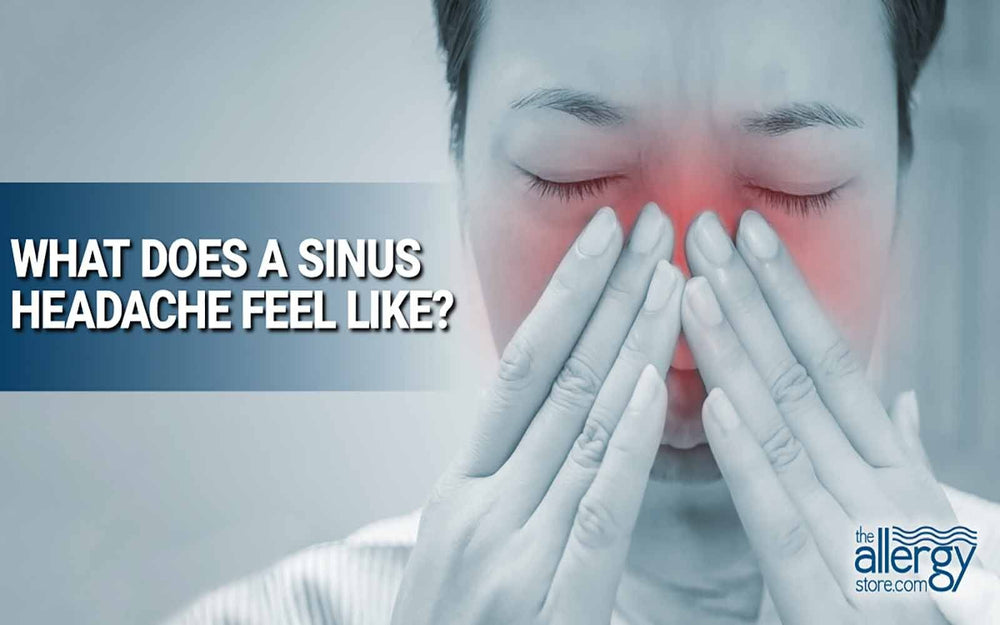
A sinus headache is a miserable constant pain that is characterized by aches over the forehead, cheekbones and the bridge of the nose. It worsens when you bend over or move your head suddenly.
It is also typically worse in the morning and it gets better as the day progresses. This pain of a sinus headache is also more painful when the weather is cold and damp. I often get them when cold fronts move in.
What Causes a Sinus Headache
Sinuses are spaces behind your forehead and cheekbones that are filled with air. A sinus headache develops when the drainage of mucus in these spaces is obstructed. This obstruction can be caused by allergies or infections.
The blockage of the channels in the sinuses results in the mucous building up inside the sinuses where it forms an excellent breeding ground for bacteria. This congestion of mucus thus leads to infection and inflammation in the sinuses known as sinusitis.
Other signs and symptoms of a sinus headache include a sensation of pressure over the sinuses which are located behind the forehead and the cheekbones. A pain that follows a head cold that has not cleared up within 10 days is another symptom that is suggestive of a sinus headache.
Sinus headaches that are caused by allergies are seasonal and have allergy symptoms like nasal congestion, sneezing, itching of the nose and a runny nose. They may also be associated with itchy, watery eyes, a sensation of fullness in the ears, postnasal drip and other symptoms of hay fever.
Sinus headaches that are caused by infections are associated with other symptoms of the infection like fever, decreased the sense of smell, pain over the teeth and thick, discolored nasal discharge.
Since other types of headaches can also present with pain over the forehead that is aggravated by movement and associated with watery eyes, it is important to differentiate these types of headaches since having different treatments.
Other Types of Headaches
Migraine headaches are usually throbbing headaches of moderate to severe intensity while sinus headaches are constant pains of mild to moderate intensity. In addition, migraines more often than not involve one side of the head and can be localized to an eye or one temple. They are also associated with sensitivity to light and sound which do not occur with sinus headaches.
Other symptoms that may suggest the cause of the headache to be a migraine include nausea, vomiting, worsening of the pain with activity and an aura which is a visual disturbance that precedes the migraine pain.
Tension headaches which are caused by muscle tightness from stress or holding the head in an abnormal position are other pains that need to be distinguished from sinus headaches because they are often felt across the forehead. However, tension headaches are not associated with other symptoms.
Cluster headaches also need to be differentiated from sinus headaches because they occur in cycles that can be confused with sinus headaches caused by allergies. However, cluster headaches cause a very severe headache that affects only one side of the head.
Sinus Headache Relief
There are several at-home steps that help prevent sinus headache or alleviate its pain. They include:
Breathe moist air: Relief for a sinus headache can be achieved by humidifying the dry air environment. This can be done by using a steam vaporizer or cool-mist humidifier, steam from a basin of hot water, or steam from a hot shower.
Alternate hot and cold compresses: Place a hot compress across your sinuses for three minutes and then a cold compress for 30 seconds. Repeat this procedure three times per treatment, two to six times a day.
Nasal irrigation: The oldest form of nasal irrigation is the neti pot and it is still popular today. It was developed in ancient India. The word “neti” is Sanskrit for “nasal cleansing”.
Neti pots look a bit like Aladdin’s lamp or an elongated teapot. They work by using the force of gravity to send a stream of warm saline solution into one nostril and out the other.
Some believe that when nasal irrigation or rinse is performed, mucus, allergy creating particles and irritants such as pollens, dust particles, pollutants and bacteria are washed away, reducing the inflammation of the mucous membrane. Normal mucous will fight infections and allergies better and will reduce the symptoms. Nasal irrigation helps shrink the sinus membranes and thus increases drainage.
When it comes to nasal irrigation, you’ve got choices. You can use the traditional neti pot or an easy to use squeeze bottle system like the SinuAir Nasal Wash System. If you are into the latest equipment, check out the SinuPulse Elite Nasal Irrigation System.
Over-the-counter medications: Some over-the-counter (OTC) drugs are highly effective in reducing sinus headache pain. The primary ingredient in most OTC pain relievers is aspirin, acetaminophen, ibuprofen, naproxen, or a combination of them. The best way to choose a pain reliever is by determining which of these ingredients works best for you.
Decongestants: Sinus pressure headaches caused by allergies are usually treated with decongestants and antihistamines. In difficult cases, nasal steroid sprays may be recommended.
Alternative medicine: Chinese herbalists use Magnolia Flower as a remedy for clogged sinus and nasal passages. In conjunction with other herbs, such as angelica, mint, and chrysanthemum, it is often recommended for upper respiratory tract infections and sinus headaches, although its effectiveness for these problems has not been scientifically confirmed.
If none of these preventative measures or treatments are effective, a visit to an ear, nose, and throat specialist may be warranted.
Wishing you the best of health
The Allergy Store

